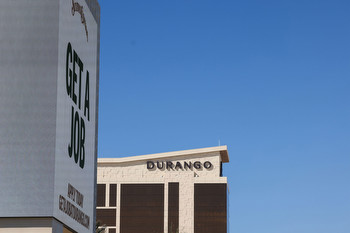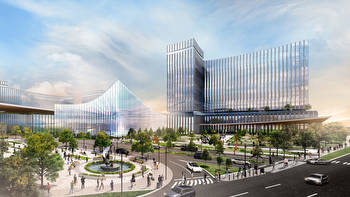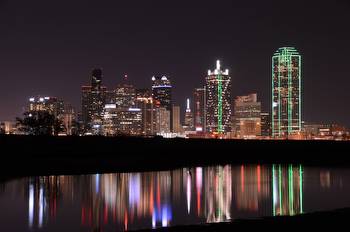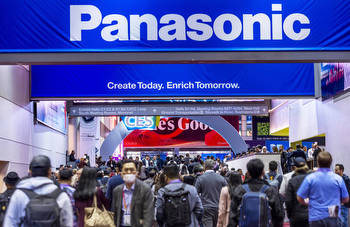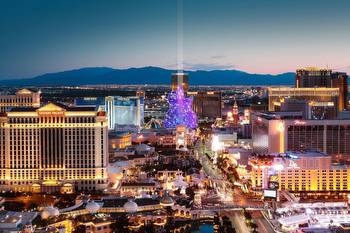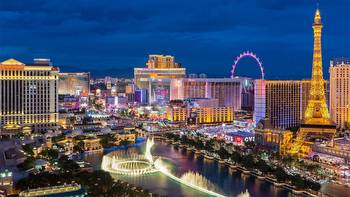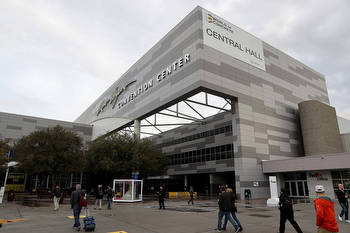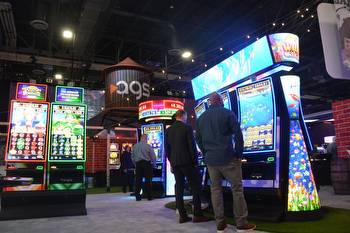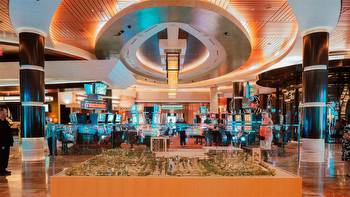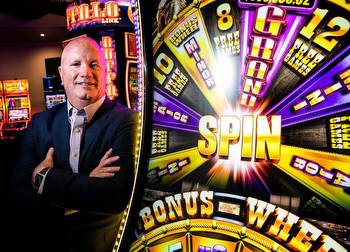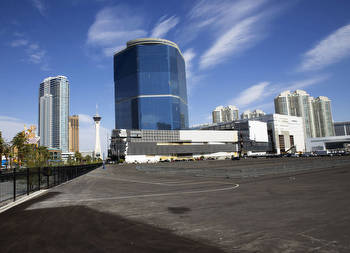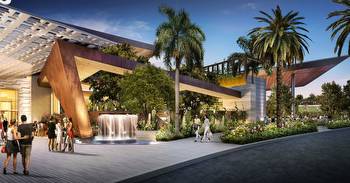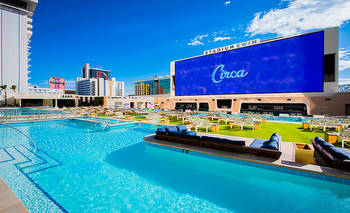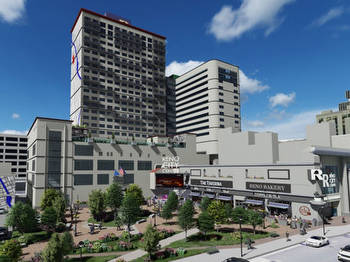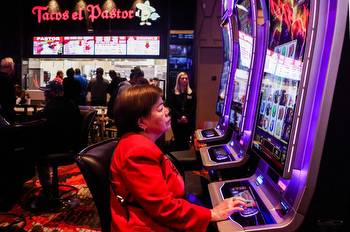Indy Gaming: After $600M renovation, what’s next for Las Vegas Convention Center?
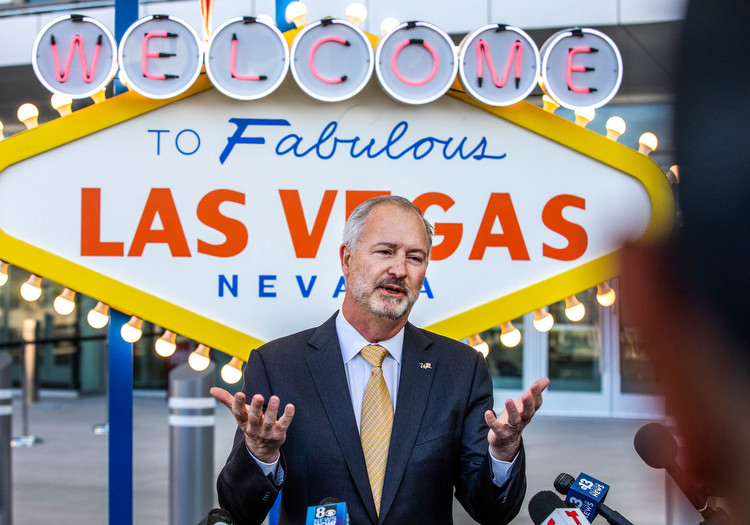
LVCVA CEO Steve Hill said the facility now has more than 15.4 million square feet of meeting space —enough to attract additional events.
Good morning, and welcome to the Indy Gaming newsletter, a weekly look at gaming matters nationally and internationally and how the events tie back to Nevada.
If a colleague or associate emailed this newsletter to you, please to sign up and receive your own copy of Indy Gaming in your inbox. - Howard Stutz
Las Vegas Convention and Visitors Authority (LVCVA) CEO Steve Hill anticipates that the ongoing $600 million renovation of the Las Vegas Convention Center would help attract another 100 trade shows and conferences, each with an estimated 100,000 attendees that have yet to book dates in the market.
“We’ve identified the shows that make sense to have in this building,” Hill told reporters on Monday as LVCVA representatives toured portions of the convention center’s South Hall that were the initial focus of the renovation project that began last year.
“Our leisure travelers have the best experience in the world when they come to Las Vegas,” he added ahead of Tuesday’s kickoff for the Consumer Electronics Show, which is expected to draw 130,000 attendees.
“Our business travelers expect the same thing and we want to deliver that promise,” Hill said.
Las Vegas has experienced a surge in the convention and meetings business in the past two years that more than made up for business lost in pandemic-affected 2020 and 2021. According to the LVCVA, convention attendance in 2023 through November has reached almost 5.8 million, 21 percent ahead of this point in 2022. The convention center alone has scheduled 48 trade shows with a combined 1.2 million attendees so far this year.
December’s opening of Fontainebleau Las Vegas saw another 550,000 square feet of convention space added to the Strip, boosting Southern Nevada’s meeting and conference capacity to more than 15 million square feet.
Now at 2.5 million square feet, Hill said the Las Vegas Convention Center is done growing.
There are two other convention facilities with more than 1 million square feet — the 2.25 million-square-foot Venetian Expo and the 1.8 million-square-foot Mandalay Bay Events Center.
Convention business helps fill the Las Vegas market’s 156,000 hotel rooms — through November, visitor volume is up more than 5 percent to 37.4 million.
“Our customers have learned there are opportunities to build on or expand the experience,” Hill said, citing the National Finals Rodeo, which attracted 180,000 people during the 10-day event. “We probably have 500,000 people in town over those 10 days who come here for the experience.”
The opening of the $1 billion West Hall in 2021 added 1.4 million square feet of meeting and exhibition space to the convention center. Hill said interest by customers at the West Hall allowed the LVCVA to move forward with renovation plans for the rest of the facility.
The $600 million project was funded through a combination of room tax money raised by the 2016 legislation that also helped finance Allegiant Stadium, bonds and authority reserve funds.
During the nine-month project, the South Hall received a new entrance on the east side of the facility with a 1,500-space parking lot directly across the street, access to the convention center’s underground Vegas Loop, indoor and outdoor plazas and renovations to the 800,000 square-foot exhibit hall.
New corporate offices were also constructed, along with a 4,400-square-foot boardroom — nearly doubling the size of the former boardroom in the Central Hall. The boardroom includes a 32-foot-by-9-foot LED screen for presentations and videos.
“We gave the South Hall a real entrance that allows us to market and sell [the space] to potential new customers that we haven't had in the building,” Hill said. “It feels welcoming. Those kinds of things matter to our existing shows. We’ve opened this part of the Convention Center to smaller shows that we haven't been able to fit into the building. They're excited about that opportunity.”
Hill said the South Hall wasn’t the convention center’s oldest building. The Central Hall was opened in 1959 and is nearly 65 years old. The North Hall is 41 years old. A grand lobby will replace the entrance between the locations, which will include a renovation of the Central Hall concourse with carpeting, lighting and digital screens. The West Hall’s exterior ribbon roof will be extended to the North and Central halls to create continuity.
“You can see how spectacular the West Hall is,” Hill said. “The differences between those halls were something that needed to be rectified for our customers.”
F1 names Betsy Fretwell as COO of the Las Vegas Grand Prix
Betsy Fretwell, who spent three decades in public sector and private business leadership roles, was named chief operating officer of the Formula One Las Vegas Grand Prix on Tuesday.
Fretwell will be responsible for the year-round operation of the Grand Prix, including developing a business surrounding Grand Prix Plaza, the $500 million centerpiece for the annual race. She will also oversee community relations.
Fretwell will report to Las Vegas Grand Prix CEO Renee Wilm, who is the chief legal officer of Colorado-based Liberty Media, which owns Formula One.
In a statement, Fretwell said she will work with local government, tourism and community leaders on planning for the annual race, which is scheduled for Nov. 23. The first Las Vegas Grand Prix took place last November.
Fretwell, who owns a consulting company, spent 27 years in the public sector, including nine years as city manager of Las Vegas. She also served as an executive with information technology infrastructure provider Switch. Fretwell is the chairwoman of the Vegas Chamber Board of Trustees and is on the boards of the Las Vegas Global Economic Alliance and Las Vegas Events.
Red Rock looks to expand Durango and grow the company’s LV footprint
The $780 million Durango Casino Resort is barely a month old, but the investment community is already anticipating Red Rock Resort’s next Las Vegas development.
The company owns six sites with gaming entitlements covering more than 500 acres in regions stretching to the outer ends of Clark County, including a 128-acre parcel on the southern end of Las Vegas Boulevard.
The land gives Red Rock a road map for future projects. Company executives estimated more than 70 percent of Clark County's future population growth will be located within 3 miles of an existing Red Rock property or near one of the development sites.
“We believe this aspect of the Red Rock story is underappreciated by investors,” Stifel Financial gaming analyst Steven Wieczynski wrote in a Dec. 20 research note shortly after Durango opened on Dec. 5. “These real estate holdings provide an attractive pipeline for future growth as well as a moat protecting the company’s dominance in the Las Vegas locals market.”
A week after opening, Red Rock’s top executives, including Chairman and CEO Frank Fertitta III and Vice Chairman Lorenzo Fertitta, hosted several Wall Street analysts for a day at the newest property. Their visit included a tour of Durango, a diner at the resort, a presentation on the company’s land holdings and a question and answer session with the Fertittas, Chief Financial Officer Stephen Cootey and President Scott Kreeger.
Durango consists of an 83,000-square-foot casino, 201 hotel rooms, 20,000 square feet of convention and meeting space and four full-service restaurants along with a 25,000-square-foot food hall with 10 outlets.
The company has completed designs for the second phase, which is expected to include an additional 400-600 hotel rooms, a casino floor expansion, more convention space and entertainment options, including a movie theater and bowling center.
However, management said the expansion might not begin until later this year.
The development pipeline drew much of the analysts’ attention.
Truist Securities gaming analyst Barry Jonas said Red Rock is initially considering two of the sites — a 48-acre location within Skye Canyon in the Las Vegas Valley’s far northwest along U.S. Highway 95, and 49 acres in the west Henderson community of Inspirada.
Jonas suggested the projects would be smaller than Durango and have a lower cost.
Analyst raises red flags for investors in Boyd Gaming and Monarch
One gaming analyst told investors last week that Boyd Gaming could be facing financial headwinds in its regional markets.
Las Vegas-based Boyd operates 28 casinos in 10 states and manages a tribal casino in Northern California.
For the first nine months of 2023, the company’s Las Vegas casinos — located in downtown Las Vegas and other areas outside of the Strip — combined to bring in more than $852 million in revenue. Separately, Boyd’s regional casino markets nearly doubled that figure with more than $1.5 billion.
However, Stifel Financial gaming analyst Steven Wieczynski told investors in a Jan. 4 research note that the gaming fundamental outlook for states outside of Nevada “appears uninspiring if not concerning.”
Wieczynski gave Las Vegas high marks for its positive economic trends and a low state gaming tax — 6.75 percent on revenue — as a better opportunity than regional markets. He praised Boyd’s management team and the company’s “clean” balance sheet with just under $3 billion in debt.
However, “an unfavorable outlook for broader regional gaming fundamentals” may become a drawback heading into the year, Wieczynski told investors. “We move to the sidelines for the time being,” suggesting that shareholders hang on to their Boyd stock.
Wieczynski has a similar message for shareholders of Reno-based Monarch Casino and Resorts. The company that owns the Atlantis in Reno and the Monarch Casino in Black Hawk, Colorado, is facing a more competitive environment from other Reno casino operators.
He criticized the effort, calling it “a mostly idiosyncratic headwind that seems unlikely to change barring meaningful improvement in underlying player behavior.” Wieczynski suggested the increase in promotional costs in Reno was due to competition from Northern California tribal casino operators.
Hornbuckle leads gaming executives as hockey industry influencers
Led by MGM Resorts International CEO Bill Hornbuckle, the gaming industry was well-represented in the annual “People of Power and Influence” listing by The Hockey News. Hornbuckle was ranked 42nd overall by the publication, considered the leading authority on hockey nationally and worldwide.
In the non-hockey executive list, Hornbuckle ranked first, given the casino company’s partnership with the NHL, the Stanley Cup Champion Vegas Golden Knights and ownership of T-Mobile Arena.
Sports betting dominated the non-hockey executive list with Adam Greenblatt, CEO of BetMGM, Penn Entertainment CEO Jay Snowden, DraftKings CEO Jason Robins and FanDuel CEO Amy Howe all listed in the top 10. Michael Rubin, the founder of Fanatics, and SportRadar CEO Carsten Koerl, were No. 13 and 14, respectively.








